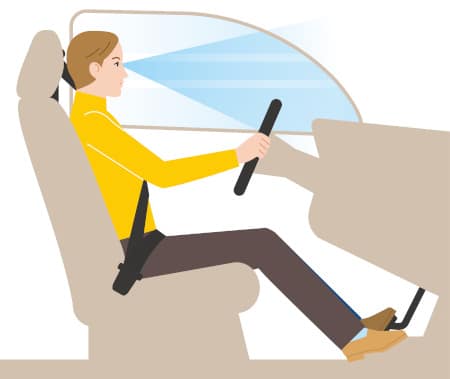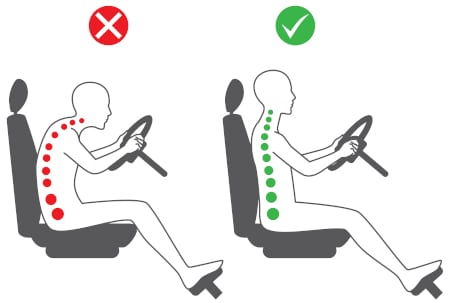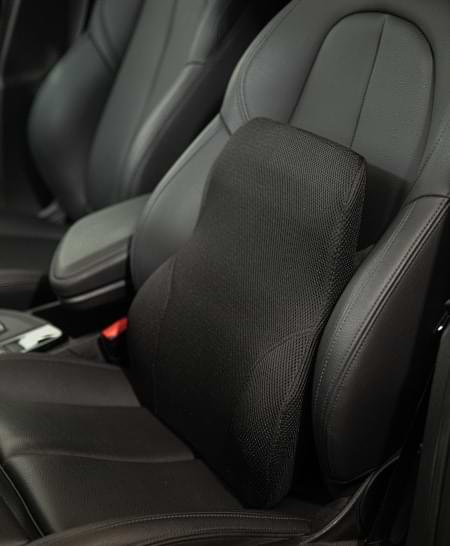Ergonomics in the car: avoid back pain thanks to a correct sitting posture
Attention to ergonomics and adopting a correct posture is important not only while we sleep or work, but also when we are on the road. Sometimes we sit in the car longer than we would like. A proper sitting posture in the car will help you avoid physical complaints such as back pain or neck pain. In this article, we give a number of tips for good ergonomics behind the wheel. Have a good ride!
Back pain due to driving
At some point in their lives, back complaints affect 80% of the population. A lack of variation and extended periods of poor sitting posture are major causes of back problems. The common belief is that sitting doesn’t exert much strain. The lower intervertebral discs and vertebrae actually exert more stress in a sitting position than in a standing position, because they are then subjected to more pressure. Incorrect sitting postures – such as slouching – should absolutely be avoided.
There are two distinct forms of sitting: the active and passive sitting postures. Active sitting involves maintaining an upright posture, avoids leaning, and your back is slightly arched. This posture is the best from a medical point of view: the back and abdominal muscles are tightened and reduce the pressure on the lower vertebrae. However, this posture cannot be maintained for long periods. After some time, you automatically sit passively, leaning back more. While it may seem comfortable, the deeper you sink into your seat, the more pressure and strain are placed on your vertebrae and pelvis. As a result, prolonged sitting – as with prolonged driving – can cause back pain.
Tips for good ergonomics in the car
Have you ever thought about how you sit in the car? In order to prevent back and neck problems, it is important that you also take ergonomics into account in the car and adopt a correct sitting position. We list a few important pieces of advice.
What is a correct sitting position in the car?
The most important thing is that you adjust the car seat to your posture.
Car seats are adjustable in height. Adjust the seat height so that you have a good view of the road. Make sure that a clenched fist still fits between the top of your head and the roof of the car. The knees are at the same height as the hips. Your upper legs are as horizontal as possible.
Ideally, the car seat’s width should exceed that of your hips and thighs. To maintain optimal blood flow in your legs, a space as wide as your fist should be left free between the front of the seat and the back of your knee. Also make sure that your upper legs are adequately supported. The seat depth should be approximately equal to the length of the thighs. If the seat depth is too great, you will sink down. If the seat depth is too short, it can lead to increased pressure in the knee cavities, leading to compressed blood vessels.
Adjust the distance of your car seat so that you can easily reach the pedals and the steering wheel while keeping your back against the seat. The pedals should be so within reach that you do not have to stretch your legs completely. You should therefore be able to reach the pedals with slightly bent legs. While driving, rest your left foot on the footrest to the left of the clutch pedal. With your back resting against the backrest, you should be able to comfortably position your wrists on the steering wheel.
Adjust the height of the steering wheel so that your hands stay below shoulder height. Your hands should be at ‘ten to two’ on the steering wheel. Your arms are slightly folded. When adjusting the steering wheel, make sure that you always have a good view of the dashboard.

Provide enough support
Your back should always be supported by the backrest, even when changing gear. The backrest preferably provides support up to your shoulders, without obstructing your rear view. The backrest’s optimal position is at an angle of approximately 100 degrees relative to the car seat. For long car journeys, it makes sense to adjust that angle every half an hour. Always keep the inclination angle between 90 and 120 degrees.
If your backrest has an adjustable lumbar support, adjust it so that you feel sufficient support in the hollow of your lower back.
The headrest plays an important role in preventing whiplash in collisions. The top of the headrest ideally coincides with the top of your head. The distance between your head and the headrest should be no more than 5 cm to protect your neck adequately in the event of a collision. While driving, your head does not normally make contact with the headrest.
It is important to invest in good car seats, but also expensive. When buying a car, make sure that the lumbar support can be adjusted to fit the curve of your lower back and that the seat depth can be adjusted to the length of your legs. A tilt of the seat support is very useful. Not all car seats can be adjusted like this.

Ergonomic aids for a correct sitting position in the car
An ergonomic seat cushion can contribute to a good sitting posture in the car. That seat cushion is a cushion that slopes upwards. This brings the buttocks to the same height as the knees. It promotes a correct and upright posture, making prolonged sitting more pleasant. You might need to adjust the car seat to a lower position, ensuring that there is at least a gap the size of a clenched fist between the top of your head and the car’s roof.
If you do not have an adjustable lumbar support for good support in the lower back, you can use a back cushion. That is a cushion with backrest with extra support in the lumbar region (lower back). The lower back thus becomes hollower, and the pelvis forms a 90° angle with the upper legs.

Also consider your back when getting in and out
To get in, sit in the seat with your back to the car. Turn in the seat while drawing your legs inside at the same time.
To get out, turn in the seat until your legs are outside the car. When standing up, support yourself on the door or on the inside of the car.
Relax, vary and take breaks
A relaxed seating position is also important. When you tense up your shoulders and arms, it results in additional strain on the muscles in your neck and upper back. During prolonged driving or while stuck in traffic, it is also important to vary the position of your backrest every 30 minutes. This could involve leaning further back at times, then leaning more forward at others, with or without the use of a lumbar support.
On long journeys, attention can sometimes slacken. Certainly if you enable the cruise control. Sufficient rest breaks while driving will not only keep you more alert in traffic. By taking a ten-minute walk or performing stretching exercises, you can alleviate the tension in your pelvic and back muscles, enabling you to resume driving in a more relaxed manner. Take a break at least every two hours. An automatic transmission can offer benefits over a manual one, as it can ease the strain on the back and shoulders.


